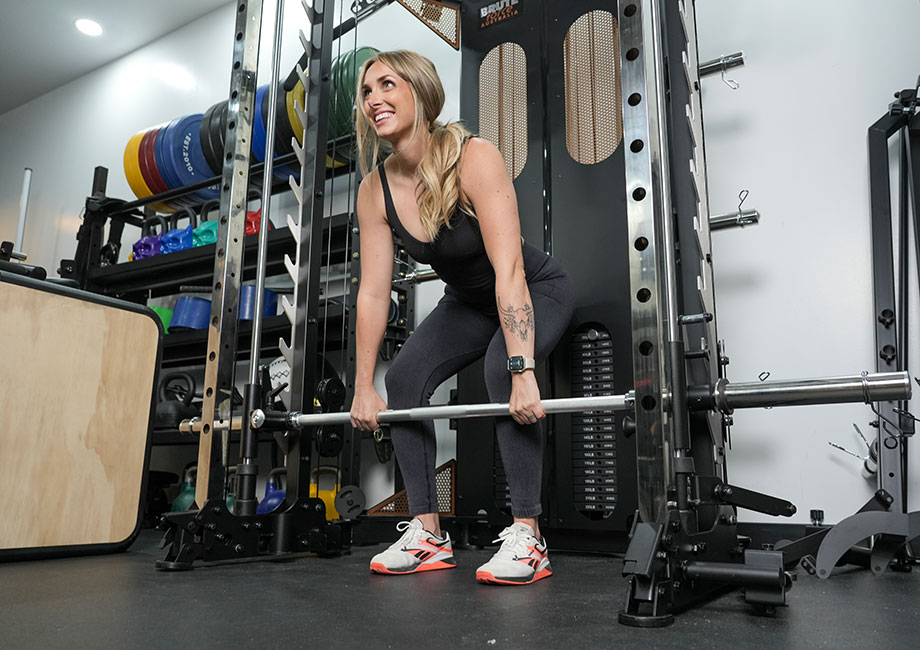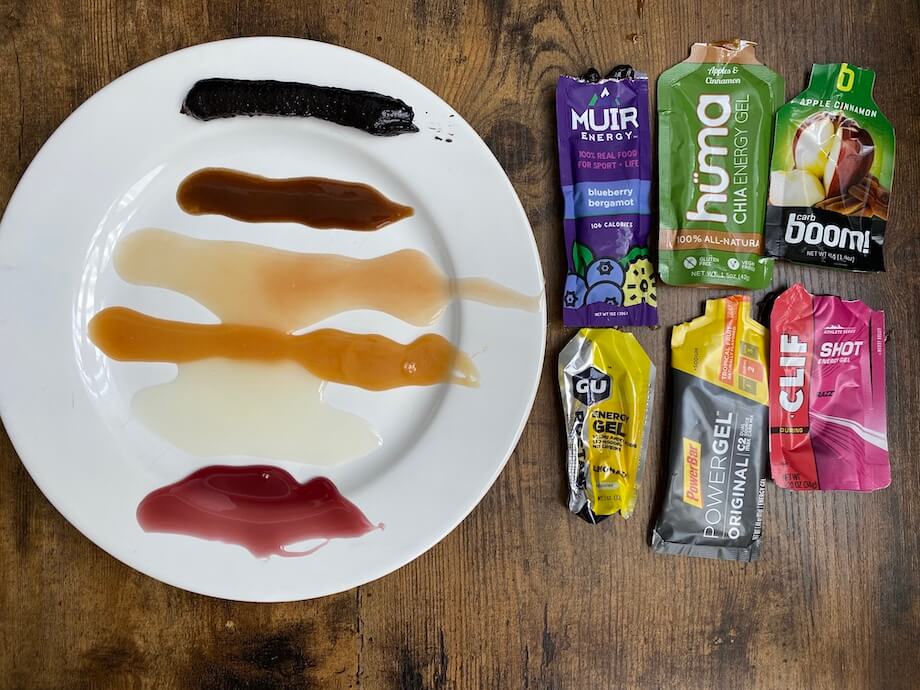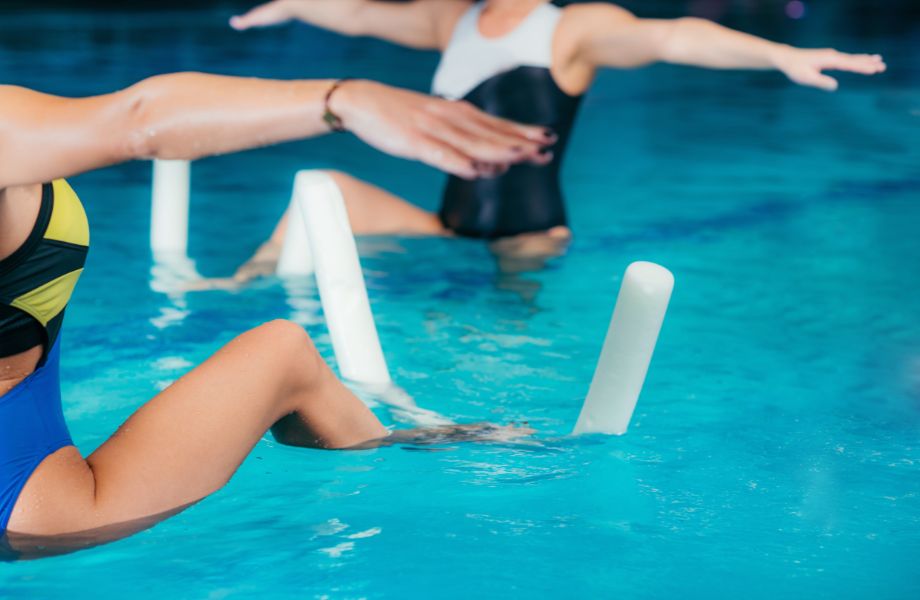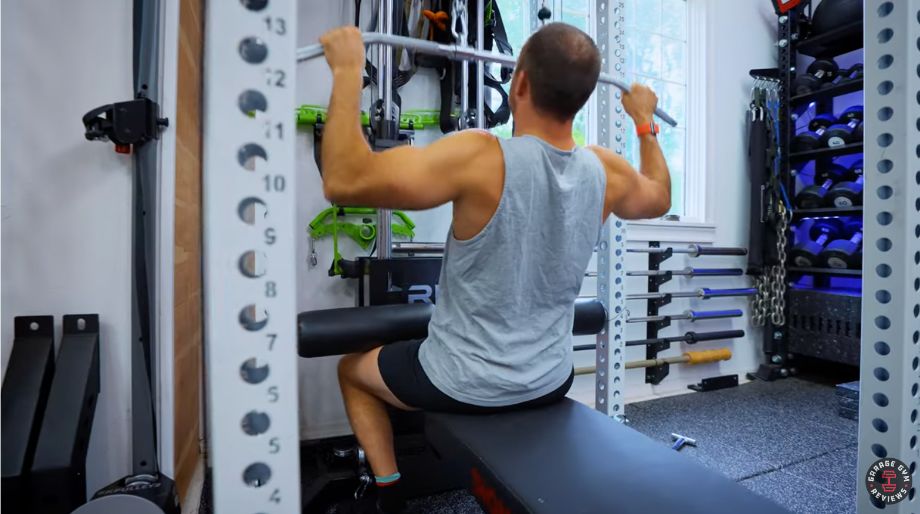Picture this: you’re at the gym and ready to go all-in on some heavy deadlifts when you encounter a problem—no available barbells! Your pre-workout just kicked in, and your warm-up is complete, so you want to deadlift stat! What can you do?
Many powerlifters and bodybuilders may scoff at the suggestion, but you most certainly can deadlift on a Smith machine, and in many ways, it’s just as good as the standard deadlift using a barbell.
RELATED: Smith Machine Workouts
Kate Meier, NASM-CPT, USAW-L1, CF-L1, and GGR senior director of fitness content, gives you a full Smith machine deadlift tutorial, benefits, alternatives, and more. Let’s lift!
How To Do the Smith Machine Deadlift
At a glance, the Smith machine deadlift is the same as the standard barbell deadlift, but two main distinctions differentiate the two: the bar path and the starting height. Smith machines operate using a fixed bar path, which may be perfectly vertical or angled, depending on the machine. Smith deadlifts also don’t rest on the floor in the starting position, shortening the range of motion and making the movement less difficult by default.
How to do it:
- Set the Smith machine to the lowest position and load the bar.
- Stand with your feet about hip-width apart and the bar over your midfoot. If the Smith machine features an angled bar path, stand on the side with the track coming toward your face. If the bar path is straight, either side works fine.
- Hinge forward by pushing your hips back, lowering your chest, and bending your knees.
- Grip the bar just outside your shins using a mixed or double overhand grip.
- Brace your core and drive through your heels to stand.
- Squeeze your glutes as your hips reach full extension.
- Slowly hinge forward again to return the bar to the starting position.
- Repeat for your desired number of reps.
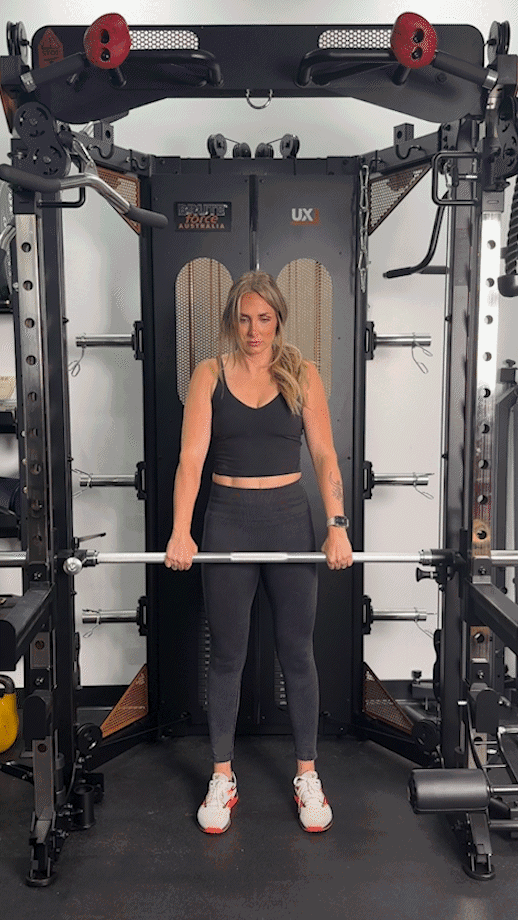
Modifications
- Dial it back: Perform your Smith machine deadlift using light weights and a shortened range of motion (the rack pull), or practice your hip hinge by performing the good morning exercise.
- Make it harder: Use heavier weights or perform the exercise unilaterally (single-leg deadlift).
How To Smith Machine Deadlift At Home
As the name suggests, you’ll need a Smith machine to do this exercise. If this equipment isn’t available, you can still deadlift at home using free weights or heavy household objects. Or, if you have the budget for one, you can purchase your own Smith machine for your home gym.
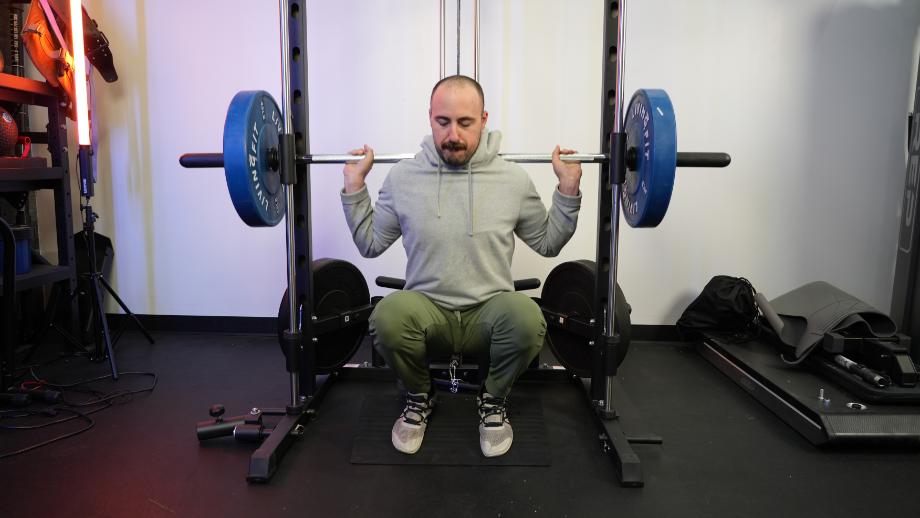
RELATED: RitFit Smith Machine Review
Smith Machine Deadlift Variations
- Smith machine Romanian deadlift: The Smith machine RDL starts standing and involves hinging forward while keeping your legs straight, shifting the primary muscle activation off your quads and onto your hamstrings.
- Smith machine single-leg deadlift: The conventional deadlift and RDL may be performed with one leg floating, turning it into a highly effective unilateral exercise.
- Smith machine rack pull: The rack pull involves shortening your range of motion to practice the end portion of the eccentric phase, thus building strength and power in the process. Set your starting position to roughly knee height, and you’re ready to rock!
Smith Machine Deadlift Alternatives
The deadlift isn’t the only compound exercise you can perform using a Smith machine. Here are a few Smith machine deadlift alternatives to round out your strength training program.
Smith Machine Hip Thrust
Why do it: According to PLoS One1, the hip thrust targets many of the same posterior chain and lower-body muscles as the deadlift and back squat but places less strain on the lower back and knee joints.
How to do it:
- Set a Smith machine to roughly the height of a weight bench and load the barbell
- Place a flat bench in front of the Smith machine so that it’s parallel with the bar.
- Sit down in front of the bench with your knees bent and feet firmly planted.
- Drive your feet into the floor and thrust your hips into the bar, unracking it. Press your upper back into the bench as your hips rise.
- Squeeze your glutes in the top position, then slowly return to the bottom.
- Repeat as needed.
RELATED: Hip Thrust Workout
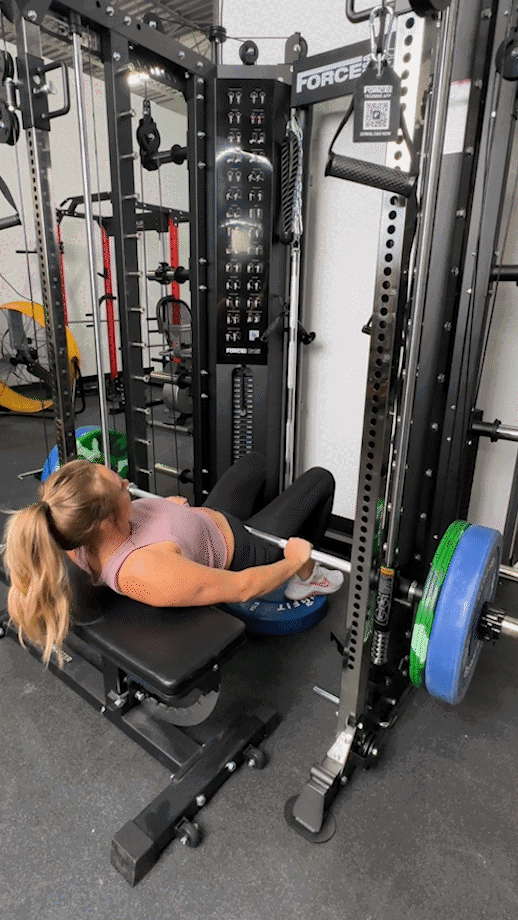
Smith Machine Squat
Why do it: The squat is one of the best compound exercises for building muscle and strength. Smith machine squats “may provide performance-enhancing benefits of equal or superior value to those obtained with free-weight squat training,” according to Sports (Basel)2.
How to do it:
- Set a Smith machine to roughly shoulder height and load the barbell.
- Stand with your feet shoulder-width apart and unrack the bar onto your shoulders.
- Push your hips back and bend your knees to squat.
- Continue until your thighs are nearly parallel with the floor.
- Pause, then drive through your heels to stand back up.
- Repeat for reps.
REPEAT: Smith Machine Leg Workouts
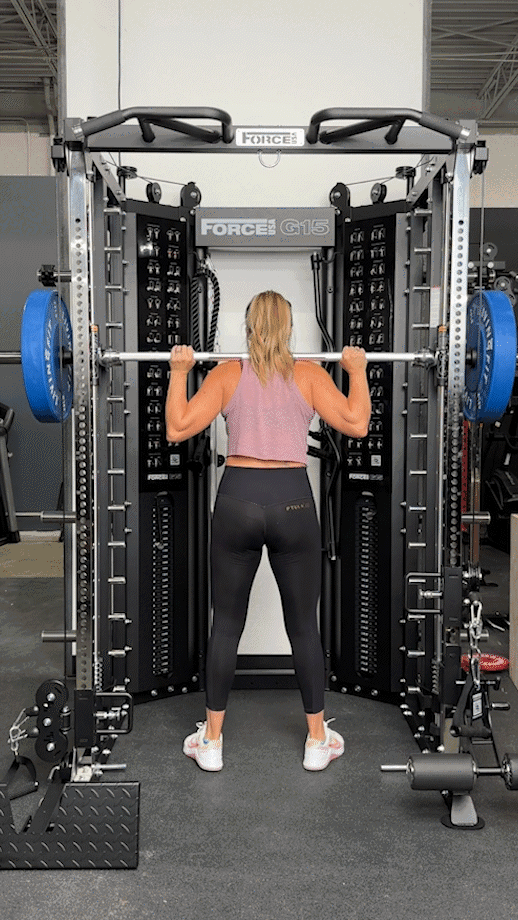
Smith Machine Split Squat
Why do it: “The split squat uses a staggered stance to effectively work one leg at a time,” says Kate Meier, NASM-CPT, USAW-L1, CF-L1. “So, you may correct muscle imbalances by performing split squats, which may help improve your regular squat performance and increase your lower-body strength.”
How to do it:
- Set a Smith machine to roughly shoulder height and load the barbell.
- Stand with your feet shoulder-width apart and unrack the bar onto your shoulders.
- Step one foot in front of the other to enter your split stance.
- Slowly lower your body, bending both knees until they form 90-degree angles.
- Pause, then drive through the heel of your front foot to stand back up.
- Complete all reps, then switch sides and repeat the set.
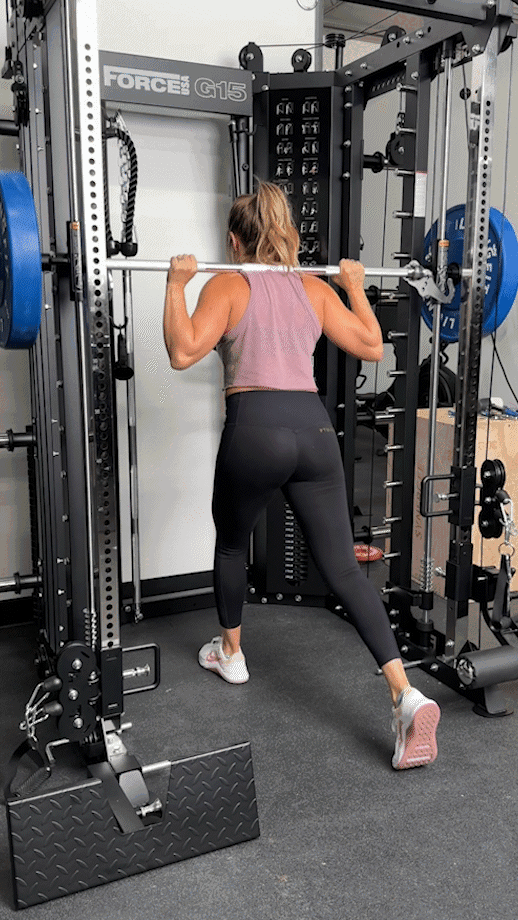
Smith Machine Good Morning
Why do it: The Smith machine lets you perform a plethora of movements, but the good morning exercise may be one of the most beneficial for supporting your deadlift success. This hip hinge exercise targets the same posterior chain muscles while stretching your lower back and hamstrings, helping you get loose and limber for your deadlifts.
How to do it:
- Set a Smith machine to roughly shoulder height and load the barbell.
- Stand with your feet shoulder-width apart and unrack the bar onto your shoulders.
- Push your hips back and lower your chest while keeping your legs straight.
- Continue until you feel a strong stretch in your hamstrings.
- Pause, then push through your feet and bring your hips forward again to stand back up.
- Repeat for reps.
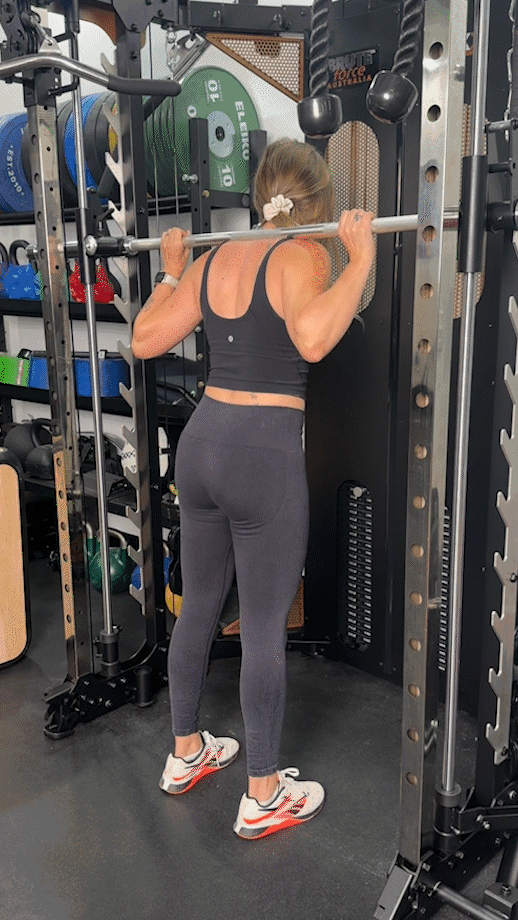
Benefits of the Smith Machine Deadlift
Sure, the standard deadlift has its perks, but, in some ways, the Smith machine deadlift gives you an edge. Here are a few benefits associated with the Smith machine deadlift.
Accessible When Barbells Aren’t Available
Most commercial gyms stock plenty of barbells, but that may not mean much if you’re visiting during peak hours and everyone else scoops them up before you do. Some gyms—looking at you, Planet Fitness—don’t offer barbells at all. In these situations, having a Smith machine available lets you deadlift without delay.
“That’s huge because, while it’s usually not a big deal to wait in everyday life, you want to get into your working sets while your muscles are still loose from your warm-up,” says Kate. “Too much downtime, and you risk losing that, along with your motivation.”
RELATED: Olympian-Made Deadlift Warm-Up
Is Beginner-Friendly
The two biggest differences between the conventional deadlift and the Smith machine deadlift are that the Smith machine imposes a fixed bar path and, in the lowest position, the weight plates of the Smith machine do not rest on the floor.
While these features may make seasoned lifters turn up their noses, they’re exactly why beginners may find the modality more approachable for learning and performing the deadlift.
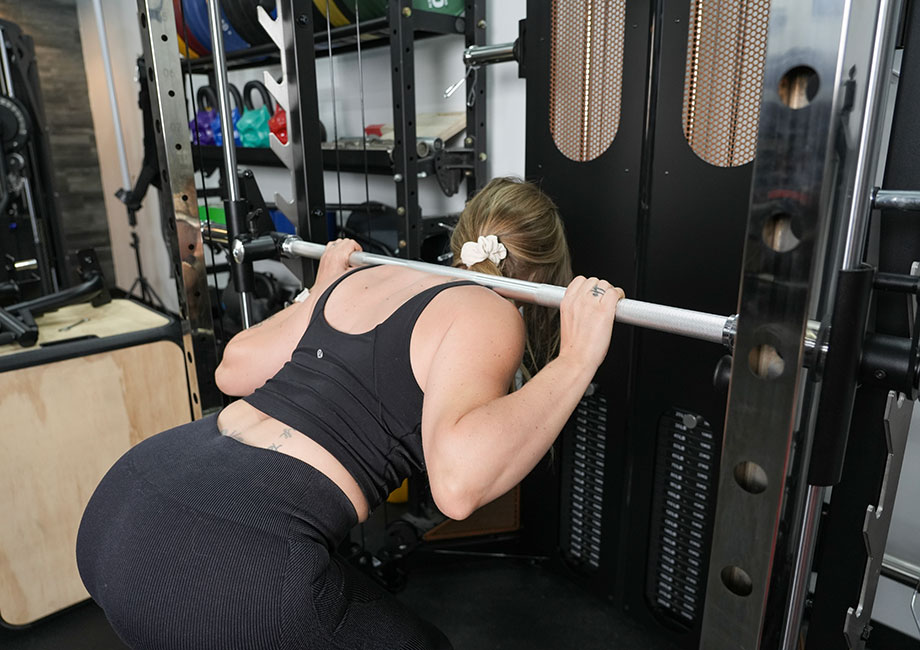
“The ideal deadlift bar path is a straight vertical line, but beginners often arc the bar around their knees when first learning,” says Kate. “Using a Smith machine takes away your ability to do this because the bar is confined to a straight vertical path.”
Because the bar stays within its track, there’s also no possible way for it to move from side to side. It’s inherently more stable, requiring less activation from your stabilizer muscles to perform the exercise.
RELATED: Try Our Ultimate 6-Week Beginner Workout Plan
Can Help Build Gain and Muscle Mass
You may think since the Smith machine makes the movement a little more manageable for beginners, you’ll have to sacrifice your gains. Think again.
A study in the Journal of Strength and Conditioning Research3 compared the effects of training with free weights versus machines, ultimately determining that both methods “resulted in similar increases in muscle mass and strength” after eight weeks.
That’s not all; a different study, published in BMC Sports Science, Medicine, and Rehabilitation4, compared the results of two groups following a six-week strength training program to determine if free weights or machines produced greater increases in maximal strength, hypertrophy, and jump performance. They found “no differences” between the two groups at the end of the study.
So, existing evidence indicates that you can get the same results using machines like the Smith machine.
RELATED: Smith Machine Vs Free Weights
Common Smith Machine Deadlift Mistakes
The Smith machine makes some aspects of the deadlift easier, but you’ll still need to practice proper form to reach your full potential. Avoid these common mistakes as you go.
Rounding Your Back
You’re on the path to proper form when you use a Smith machine to deadlift because it forces the bar to travel in a perfect vertical straight line. What it can’t do, however, is make sure your back also stays straight.
Maintaining a straight back is crucial during the deadlift, as a rounded back leaves your spine susceptible to shear forces and increases your risk of injury. There are a few reasons you may be rounding as you lift, including:
- You’re too far from the bar: Having to reach forward makes it harder to maintain a flat back and neutral spine. Position the bar directly over your midfoot before you begin.
- You’re not bracing your core: Properly bracing the core protects your trunk and spine and helps you maintain that ideal upper body posture.
- You’re not bending your knees: Unless you’re performing the RDL or a Smith machine stiff-legged deadlift, your knees should extend as you rise and bend as you return to the starting position.
- You’re going too heavy: It’s nearly impossible to lift with proper form if you’ve bitten off more than you can chew.
To prevent your back from rounding, you must identify when and why it’s rounding. Working with a certified personal trainer may help shed some light on the issue.
RELATED: Best Online Personal Trainer
Not Using the Full Range of Motion
The Smith machine shortens the deadlift’s range of motion since the bar and weight plates never touch the floor. That doesn’t mean you can cut corners further and reduce the range of motion even more.
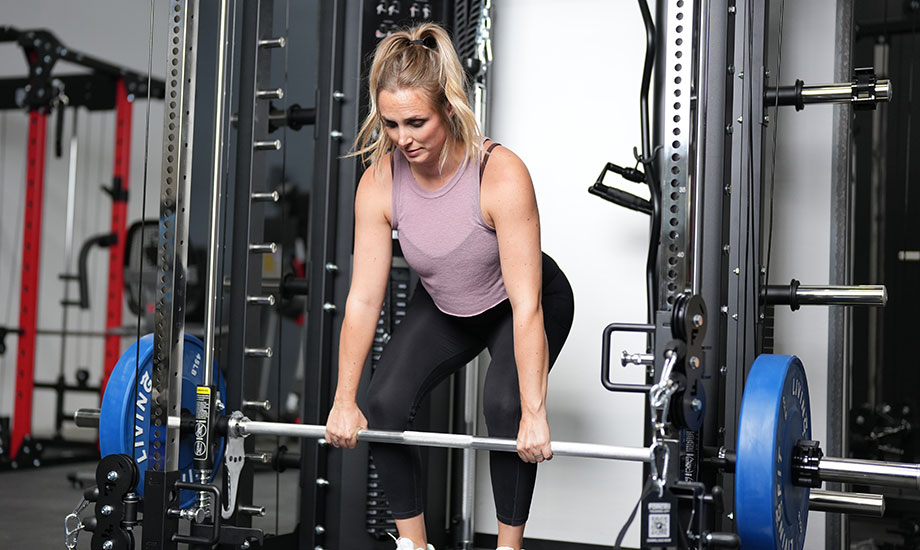
“You want your glutes contracted and your hips at full extension at the end of the eccentric phase,” says Kate Meier, NASM-CPT, USAW-L1, CF-L1. “You also want to make sure you’re going all the way back down to the starting position after the concentric phase. No shortcuts!”
Shifting Your Weight Forward
Keeping your weight focused on your heels while doing the Smith machine deadlift helps you move most efficiently, maximize power, and keep your balance during the lift. Likewise, if you’re coming up onto your toes each rep, it’s often an indication that you’re not shifting your weight back where it should be.
“Coming up onto your toes during the Smith machine deadlift may indicate poor mobility in the ankles, knees, or hips, but it usually is a sign you’re going too heavy and can’t hold proper form throughout the movement,” says Kate. “Try going lighter to correct. If that doesn’t help, working a few mobility exercises can’t hurt.”
Muscles Worked by the Smith Machine Deadlift
The Smith machine deadlift—and frankly all deadlift variations—produces muscle activation throughout your entire body, but some muscles receive more than others. The most critical muscle groups involved in the Smith machine deadlift include:
- Glutes: The glutes are fundamental for hip hinge exercises like the deadlift, as they bring your hips from flexion to extension.
- Hamstrings: The “hammies” are located on the back of your legs and help with hip flexion and extension, meaning they work with your glutes on the deadlift movement.
- Quadriceps: One of the most prominent leg muscle groups, your quads work to extend your knees, meaning they’re responsible for producing power during the critical eccentric phase of the Smith machine deadlift.
- Upper body: Your lower body gets the lion’s share of recruitment, but your core and lower-back muscles, specifically the erector spinae, work to maintain a rigid posture and neutral spinal alignment while you’re working with heavy weight, protecting you from injury.
RELATED: Deadlift: Muscles Worked
Smith Machine Deadlift: Final Thoughts
The deadlift is ostensibly one the greatest exercises of all time, so you don’t want to make a last-minute substitution if it’s in your programming just because there’s no barbell at your disposal. If you have a Smith machine, you can still get in your deadlift reps and make those gains without deviating from the plan.
Don’t sleep on the Smith machine deadlift. It’s a killer exercise and more than worthy of consideration in your strength training routine.
Smith Machine Deadlift: FAQs
Can you lift heavier on a Smith machine?
The Smith machine prevents you from moving outside its fixed bar path, which stabilizes the bar so your stabilizer muscles don’t have to work overtime. Because of this decreased workload, you can often lift heavier using a Smith machine than with free weights.
Smith machines also have safety features that eliminate the need for a good spotter. That may not mean much for the deadlift, but it’s huge for exercises like the bench press and back squat.
Is it OK to do RDLs on a Smith machine?
“You can perform RDLs on a Smith machine, and thanks to the fixed bar path, it may be the preferred method,” says GGR Senior Director of Fitness Content Kate Meier, NASM-CPT, USAW-L1, CF-L1.
Do bodybuilders use Smith machines?
Bodybuilders use various tools in their workouts to get the results they’re chasing, but the Smith machine tends to be among their favorite tools due to the pure muscle isolation it can provide.
As you may recall, one of the biggest Smith machine perks it provides is stability. Because you don’t have to expend energy holding the bar steady or recruit smaller muscle groups to isolate your target muscles.
Smith machine training carries over into bodybuilding as it allows bodybuilders to build muscle in the most prominent areas so they look competition-ready in comparatively less time than they would need using only barbells and dumbbells. In this regard, the Smith machine is one of the best tools for bodybuilding workouts.
References
- Otsuka M, Honjo T, Nagano A, Isaka T. Kinetics in lumbosacral and lower-limb joints of sprinters during barbell hip thrust compared to deadlift and back squat. PLoS One. 2021;16(7):e0251418. Published 2021 Jul 1. doi:10.1371/journal.pone.0251418
- Schwarz NA, Harper SP, Waldhelm A, McKinley-Barnard SK, Holden SL, Kovaleski JE. A Comparison of Machine versus Free-Weight Squats for the Enhancement of Lower-Body Power, Speed, and Change-of-Direction Ability during an Initial Training Phase of Recreationally-Active Women. Sports (Basel). 2019;7(10):215. Published 2019 Sep 30. doi:10.3390/sports7100215
- Schwanbeck SR, Cornish SM, Barss T, Chilibeck PD. Effects of Training With Free Weights Versus Machines on Muscle Mass, Strength, Free Testosterone, and Free Cortisol Levels. J Strength Cond Res. 2020;34(7):1851-1859. doi:10.1519/JSC.0000000000003349
- Haugen ME, Vårvik FT, Larsen S, Haugen AS, van den Tillaar R, Bjørnsen T. Effect of free-weight vs. machine-based strength training on maximal strength, hypertrophy and jump performance – a systematic review and meta-analysis. BMC Sports Sci Med Rehabil. 2023;15(1):103. Published 2023 Aug 15. doi:10.1186/s13102-023-00713-4


